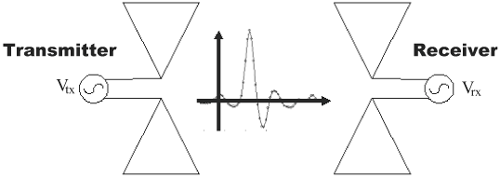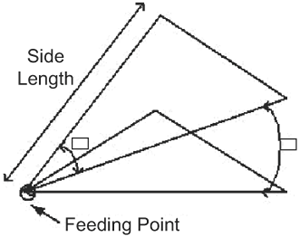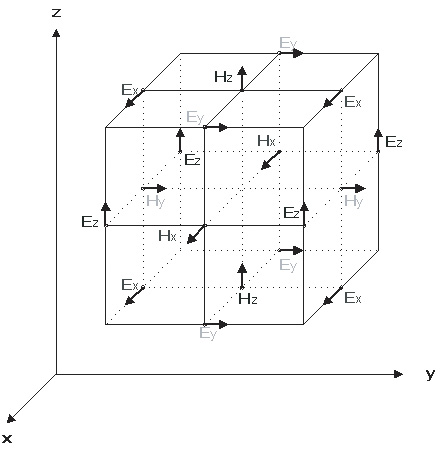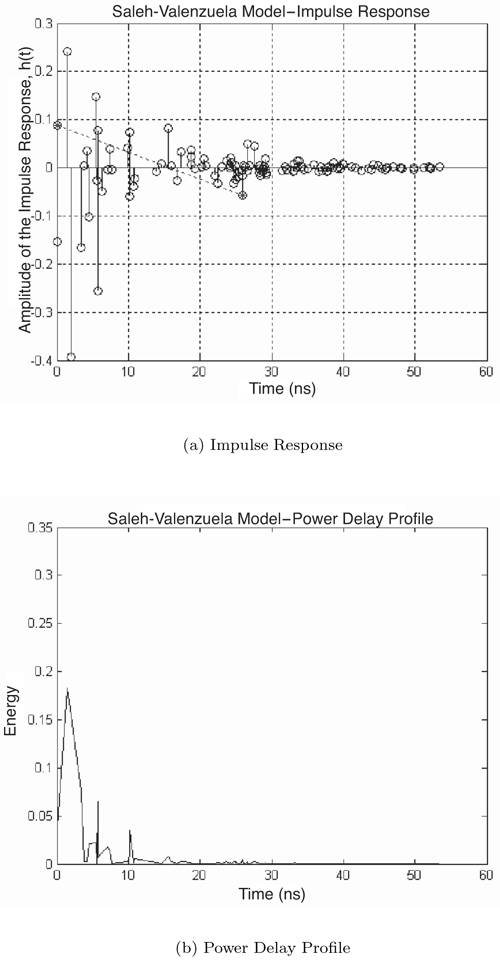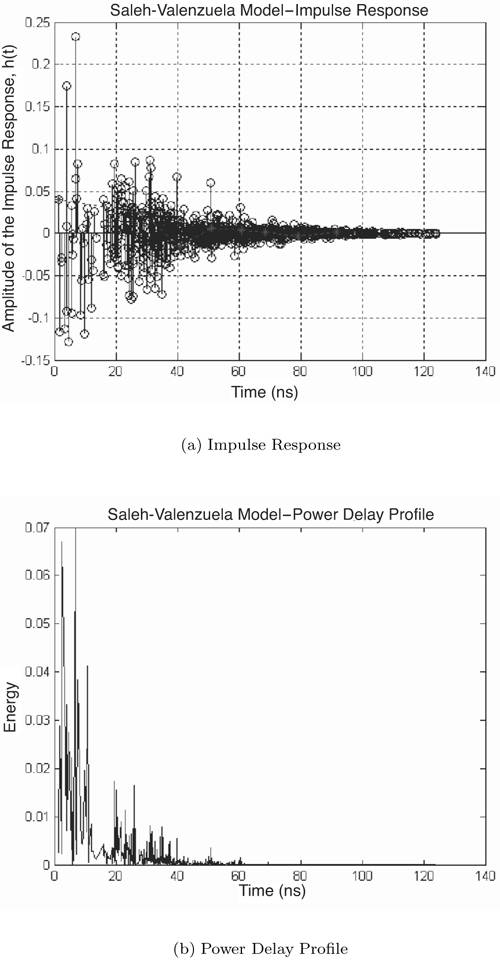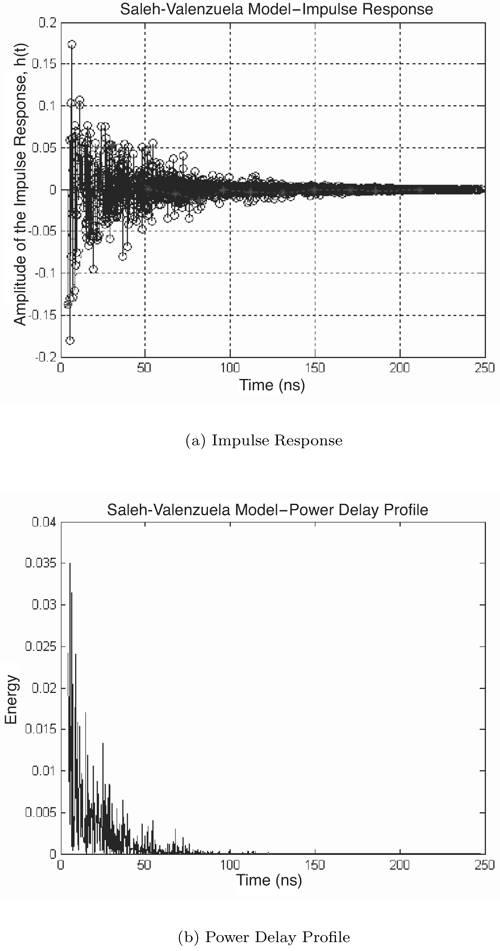Section 8.4. UWB Component Simulation
|
8.4. UWB Component SimulationThis section provides examples of the previously discussed methodologies and techniques as applied to the following UWB communication systems processes and components: pulse generation and modulation, signal amplification, antennas, and signal propagation. 8.4.1. UWB Pulse Generation and ModulationThis section discusses the steps involved in the development of a simulation for examining how modulation and pulse shaping affects system performance as measured by the BER. For the purposes of this experiment, the system model shown in Figure 8.12 is adopted. In this model, a randomly generated train of bits, which represent data, are modulated and pulse shaped. Then noise, labeled as Nx in the diagram, is added to the signal before being demodulated. The following discusses the specific models used for each component. Figure 8.12. UWB Simulation System Model. Pulse Generation and ModulationSeveral modulation techniques can be used to create UWB waveforms. Some of the most popular methods to create UWB pulse streams use mono-phase techniques, such as pulse amplitude (PAM), pulse position (PPM), or on-off keying (OOK). UWB pulses are traditionally modeled using two different models: Gaussian pulses and Gaussian monocycles. The Gaussian pulse is a frequently used conceptual model of the pulse generated at the transmitter and can be represented as Equation 8.13 where A is the amplitude of the pulse, Tc is the center time of the pulse, and Tau is a pulse-shaping parameter related to the standard deviation. As the antenna-air interface imparts a derivative on any transmitted signal, the received signal is frequently modeled as a Gaussian monocycle, which takes the form Equation 8.14 Due to device limitations, it it is difficult to transmit UWB pulses that exactly match the shapes given in (8.13) or (8.14). Reasons for this limitation include frequency-dependant effects and limitations in the transmitter that impart a certain amount of pulse distortion and dispersion (discussed in Chapter 5, "Transmitter Design"), which must be accounted for in the simulation. The simplest way to account for these differences is to simply measure a generated pulse and use the measured pulse shape in the simulation. Figure 8.13 shows a measured pulse generated by an I-UWB transmitter manufactured by Multispectral Solutions, Inc. Figure 8.13. Measured Pulse Generated by an MSSI UWB Transmitter. Simulation DevelopmentTo simplify the construction of the simulation, the channel is assumed to be AWGN and is implemented by adding normal distributed random variables to samples of the transmitted signal. The variance of the noise is calculated from the average energy of the received symbol for a specified SNR. To perform demodulation, the received signal is passed through a filter matched to the pulse shape. The result of this operation is then mapped back to bits according to maximum likelihood criteria. For this simulation, two different simulation techniques are considered: Monte Carlo and semi-analytic. In the Monte Carlo simulation, an independent normal variable is generated for each sample, with variance given by Equation 8.15 where n is the number of samples in a pulse, Ai is the amplitude of a sample of the pulse, and Eb/N0 is the desired SNR. These samples are then processed, and the BER estimate is formed by taking the ratio of the number of errors in the received bits to the total number of transmitted bits. For the semi-analytic simulation, an initial noiseless Monte Carlo simulation is performed to characterize the received signal constellation. For Binary PAM modulation, a diagram similar to the one shown in Figure 8.14 is created where S1 and S2 are the ideal constellation points, the decision regions are D1 and D2, and Figure 8.14. Constellation Diagram for Binary PAM UWB Signal. After calculating the noise equivalent bandwidth of the matched filter and applying side knowledge that the received signal is Gaussian distributed, bit error rates can be directly calculated for any SNR from Equation 8.16 For OOK modulation, the signal constellation has two points, 0 and 1, in one dimension. This means that the two constellation points in PAM have moved closer by a factor of 0.5. Therefore, the same formula for calculating the BER can be used. For PPM modulation, there are two orthogonal dimensions, and the distance between the two points is Monte Carlo Simulation ResultsThe Monte Carlo simulation assumes the following parameters: binary PAM modulation, a Gaussian noise channel, Gaussian monocycles, and measured pulses. A rectangular pulse shape is also simulated to provide a means of validating the simulation. Eight samples per pulse are assumed, and pulse amplitudes are constrained to the maximum level achieved by the rectangular pulse. With respect to the rectangular pulse, energy losses of 5.94 dB, 5.54 dB, and 8.17 dB are seen for Gaussian pulses, Gaussian monocycles, and the measured response, respectively. The simulation results for the PAM modulation case are presented in Figure 8.15. Note that these energy losses are reflected in the figure. If each pulse had the same energy, under the considered LOS AWGN conditions each pulse would have achieved the same BER. Figure 8.15. Monte Carlo Simulation Plot for Binary PAM Modulation. Semi-Analytic Simulation ResultsWhile energy-normalized pulse shaping does not have an effect on performance, the choice of modulation scheme can have a significant impact. A semi-analytic simulation was performed to study the effect of UWB modulation, particularly PAM, PPM, and OOK with Gaussian pulse shaping, and the results of this simulation are shown in Figure 8.16. Note that performance is a function of signal space separation. Recall that signal space separation of PAM is 2 Figure 8.16. Semi-Analytic Simulation Results: Received Signal Constellation and BER Versus SNR.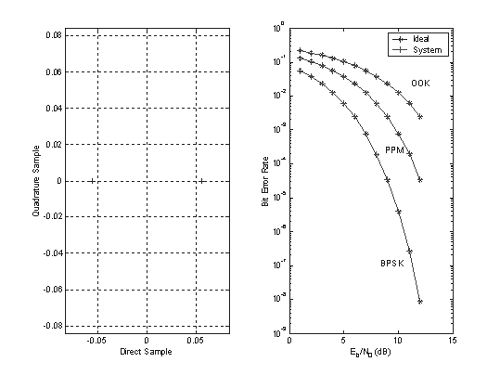 8.4.2. Signal AmplificationThis section considers the modeling, simulation, and experiment execution and analysis of signal amplification, i.e., the processes that occur in a power amplifier and low noise amplifier (LNA) in a UWB communications system. Amplifier Model DevelopmentMost traditional amplifier models, such as the tan -1 model, are predicated on narrowband assumptions. New models must therefore be developed for UWB applications. In these situations, the development of a behavioral model based on measured data is often a necessary approach. When the input signal has a bandwidth comparable to the bandwidth of the amplifier, the amplifier gain should not be assumed to be flat over the entire signal bandwidth. The input signals then induce frequency-dependent effects in the amplifier, which are visible as hysteresis on the envelope transfer characteristics or input-output characteristics of the amplifier. The modeling strategy for these amplifiers, which exhibit both nonlinearties and memory or frequency dependent effects, is a topic of active research. The most common way to introduce frequency dependencies into a system is to include a filter. A nonlinearity preceded by a linear filter is referred to as a Wiener system in control systems terminology. Figure 8.17 shows the block diagram of a Wiener system. Note that this system introduces both amplitude dependent amplitude (AM-AM) and phase (AM-PM) nonlinearities. Figure 8.17. Block Diagram of a Wiener System. Another method to model a nonlinear system with memory is to use a "nonlinear filter" or a nonlinear tapped-delay line (NTDL) [13]. As the name suggests, the model consists of an FIR structure, or tapped-delay line, with input-amplitude-dependent polynomials at each tap. Thus, the dynamic system has a nonlinearity embedded in it. Figure 8.18 shows a 3-tap NTDL, where y[n] is related to x[n] as given by Equation 8.17 Figure 8.18. 3-Tap, Pth-Order NTDL Model of an Amplifier. This modeling strategy gives us two degrees of freedom for choosing the number of coefficients-filter depth and tap nonlinearity design. The advantage of this form of modeling structure is its very convenient form for least-squares coefficient estimation [14] for signal specific time-domain modeling. For our models, the coefficients in the NTDL are determined from experiments that sounded the amplifiers to be modeled. For this study, three amplifiers from Mini-Circuits were tested and measured. Specifically, three power amplifiers (specifically the ZFL-2500 [15], ZHL-42W [16], and ZVE-8G [16] models) were measured and modeled using a NTDL approach. Upon repeated trials with different values for the filter length, tap order, and sampling frequency, the parameters listed in Table 8.1 were generated. Although increased filter lengths improve modeling accuracy as measured in terms of normalized mean-squared envelope error (NMSE), some concessions were made in trading fidelity for faster simulation execution time.
A nice feature of the NTDL amplifier model is that it is only slightly more complicated to implement than a filter. Thus, a simulation of these amplifiers can be realized by appropriately modifying the system depicted in Figure 8.18. The models created for these three amplifiers were driven by PAM modulated data to capture the power spectral densities for both the input and output signals. The spectral densities for the ZFL-2500, ZHL-42W, ZVE-8G are plotted in Figure 8.19, Figure 8.20, and Figure 8.21. Figure 8.19. PPM (Left) and BPSK (Right) Modulated Input-Output Spectral Densities for ZFL-2500.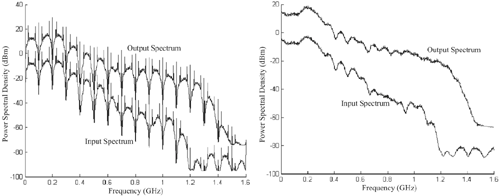 Figure 8.20. PPM (Left) and BPSK (Right) Modulated Input-Output Spectral Densities for ZHL-42W.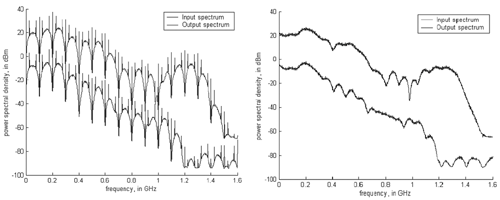 Figure 8.21. PPM (Left) and BPSK (Right) Modulated Input-Output Spectral Densities for ZVE-8G.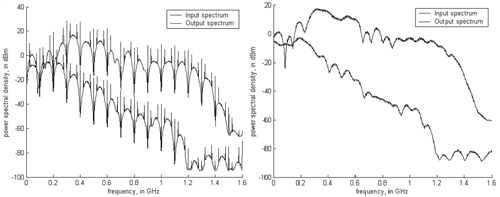 From this simulation, it is apparent that none of the amplifiers produce the desired ideally flat frequency response and that all three amplifiers introduce some spectral regrowth, with the ZFL-2500 introducing the least spectral distortion. It should also be noted that the ZVE-8G actually attenuates the signal for low input frequencies. 8.4.3. Simulation of Antenna EffectsThis section considers the modeling and simulation of the processes that occur in antennas in a UWB communications system. In this study, effort is focused on the simulation of the transfer function between the transmitter antenna and receiver antenna. The system can be modeled as shown in Figure 8.22, where Vtx is the signal input to the transmit antenna and Vrx is the signal output from the receive antenna. Figure 8.22. Configurations for Simulation of Antennas Transmitting a UWB Pulse. In particular, this section considers the simulation of a TEM horn antenna. A TEM horn antenna consists of triangular conductors joined to form a V-shaped structure as shown in Figure 8.23. A TEM horn antenna is completely characterized by its side length, apex angle, a, and elevation angle, b. Figure 8.23. Geometric Model of a TEM Horn Antenna. Antenna Model DevelopmentA block diagram for a simple antenna model is shown in Figure 8.24. Here both antennas are modeled as bandpass filters with the transmit antenna imparting a first derivative on the signal. Figure 8.24. Simplified UWB Antenna Model Using Only Differentiation and Pulse Shaping. More complex models can be constructed by applying time-varying versions of Maxwell's equations to the antenna to characterize the propagation of the electrical and magnetic fields. An exact solution of these equations can be quite complex. However, techniques have been developed that approximate the solution by sampling both the space and time components of the solution. One such technique is the FDTD (Finite Difference Time Domain) approach proposed by K.S. Yee [17], where time-dependent Maxwell's equations are sampled in both the time and space domains in unit cells to form a more tractable problem of planar geometries. The end result of the FDTD method is the creation of a time-varying spatial lattice shown in Figure 8.25 with finite difference equations for the electrical and magnetic fields associated with each plane. A more extensive treatment of the FDTD model is presented in [18-20]. Figure 8.25. Yee Space Lattice Used in FDTD Antenna Modeling. An FDTD model has the following advantages:
Simulation DevelopmentTo construct an FDTD simulation, we first calculate all elements of the magnetic field at all points in the lattice. Time is then advanced by a specific timestep and all elements of the electric field are calculated. The process of iteratively calculating magnetic and electric fields repeats until convergence is achieved. Because the FDTD method requires significant memory and processing time, techniques have been developed for reducing simulation runtime. One of the simplest techniques is to exploit antenna symmetry to calculate only a single symmetric component of the antenna [19]. Figure 8.26 depicts a symmetric antenna where the computational volume of the Yee lattice is reduced to an eighth of its original volume. This then implies that memory and cycle requirements are also reduced to an eighth of the original requirements. Figure 8.26. Reduced Computational Volume by Exploiting Antenna Symmetry. ValidationTo validate the FDTD simulation, the simulation results are compared with collected data and also compared with the relative performance of the FDTD simulation methodology for a Ka-band coaxial to waveguide transition structure. Because the simulation was intended to specifically model the TEM-horn antenna suggested in [21], the data provided in [21] is compared with the simulation results. This comparison is illustrated in Figure 8.27. The errors in tails of the wave are caused by scattering and reflection in the RX antenna. Because the distance between the TX and RX antennas is relatively small compared to the far-field distance, the superposition of the propagating waves from the TX antenna and reflecting wave from the RX antenna introduces some error in the tails. These errors can be reduced by increasing the distance between the TX and RX antennas, but this also increases the memory requirements and necessitates the use of a near to far-field transformation. Therefore, under typical simulation constraints, accuracy has to be traded off for simulation runtime. Figure 8.27. Comparison of Simulated and Measured Antenna Response to a UWB Pulse.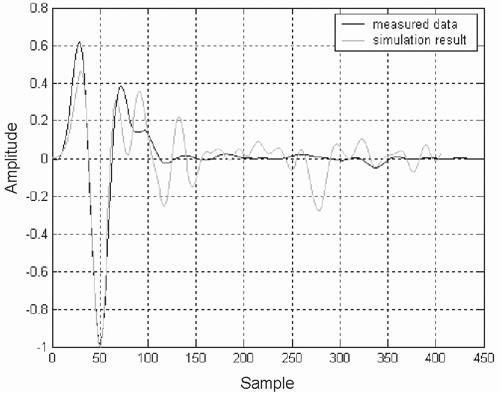 8.4.4. Simulation of UWB ChannelsThis section considers simulation strategies for the small-scale UWB channel with particular attention paid to the Saleh-Valenzuela model. Model DevelopmentUnlike narrowband signals, in UWB the amplitude distribution of each resolved multipath in a small scale channel differs significantly from a Rayleigh distribution. This arises from the multipath components of a UWB signal being comprised of a small number of scatterers. According to [22], the best-fit distribution of the small-scale magnitude statistics is the Nakagami-m distribution [23], corresponding to a Gamma distribution of energy gains. Let the gamma distribution G (Wk,mk) denote the distribution that fits the energy gains of the local path delay profiles (PDPs) in the kth bin. The Wk's are given as Equation 8.18 Another model proposed for the UWB channel is the Saleh-Valenzuela (S-V) model [5], which is based on indoor multipath propagation measurements using 10 ns, 1.5 GHz, radar-like pulses with a time resolution of about 5 ns in a medium-sized office building. In this model, the received signal rays arrive in clusters. Each received ray has uniformly distributed phase and Rayleigh distributed amplitude with a variance that decays exponentially with cluster and ray delays. The phase components can be treated as a uniformly distributed delay over a very narrow window of time. The cluster arrival times, which are the arrival times of the first rays of the clusters, are modeled as a Poisson arrival process with a fixed rate, L. Within each cluster, subsequent rays also arrive according to a Poisson process with a different fixed rate, l. Typically, each cluster consists of many rays, and thus l << L. The arrival time of the first cluster, T0, and the arrival time of the first ray within the lth cluster, t0l, are defined as 0. Therefore, the cluster arrival time, Tl, and ray arrival time, tkl, are described by the independent inter-arrival exponential probability density functions as given by Equation 8.19 and Equation 8.20 The channel impulse response for the S-V model is given by Equation 8.21 where bkl is a random variable uniformly distributed over [0, 2p), and bkl is a Rayleigh distributed random variable whose mean square value E {b2kl} is defined Equation 8.22 where E {b2 (0, 0)} is the average power gain of the first ray of the first cluster, and G and g represent the power-delay time constant for the clusters and the rays, respectively. Generally, the clusters overlap and rays and clusters extend over an infinite time as shown in (8.22). To address this issue, stopping criteria for the outer and inner sums have been developed and are exp (Tl/g) << 1, and exp (tkl/g) << 1, respectively. Simulation DevelopmentTo construct a simulation of a S-V channel model, the following procedure can be applied:
The channel model is then realized with a complex filter. ValidationTo validate the S-V model, we can use the parameter sets given in [5], which provide the median value of RMS delay spread based on 150 measurements in seven rooms. Table 8.2 shows the default parameters used for the validation and the result.
To examine the flexibility of the model, several channel realizations were simulated according to the parameter sets listed in Table 8.3.
Figures 8.28 through 8.31 depict the impulse response and the power delay profile for the Saleh-Valenzuela with these four parameter sets. Figure 8.28. Simulated Saleh-Valenzuela Channel Model with Parameter Set #1.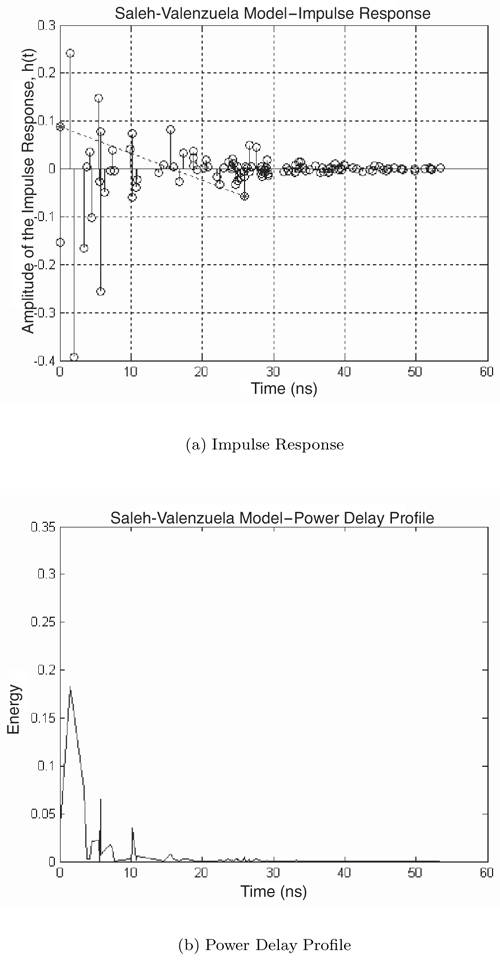 Figure 8.29. Simulated Saleh-Valenzuela Channel Model with Parameter Set #2. Figure 8.30. Simulated Saleh-Valenzuela Channel Model with Parameter Set #3. Figure 8.31. Simulated Saleh-Valenzuela Channel Model with Parameter Set #4. |
|
EAN: 2147483647
Pages: 110




